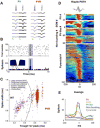In vivo optogenetic identification and manipulation of GABAergic interneuron subtypes
- PMID: 24440414
- PMCID: PMC4024355
- DOI: 10.1016/j.conb.2013.12.013
In vivo optogenetic identification and manipulation of GABAergic interneuron subtypes
Abstract
Identification and manipulation of different GABAergic interneuron classes in the behaving animal are important to understand their role in circuit dynamics and behavior. The combination of optogenetics and large-scale neuronal recordings allows specific interneuron populations to be identified and perturbed for circuit analysis in intact animals. A crucial aspect of this approach is coupling electrophysiological recording with spatially and temporally precise light delivery. Focal multisite illumination of neuronal activators and silencers in predetermined temporal configurations or a closed loop manner opens the door to addressing many novel questions. Recent progress demonstrates the utility and power of this novel technique for interneuron research.
Copyright © 2013 Elsevier Ltd. All rights reserved.
Figures



Update of
-
In vivo optogenetic identification and manipulation of GABAergic interneuron subtypes.ArXiv [Preprint]. 2023 Nov 17:arXiv:2311.10410v1. ArXiv. 2023. Update in: Curr Opin Neurobiol. 2014 Jun;26:88-95. doi: 10.1016/j.conb.2013.12.013. PMID: 38013885 Free PMC article. Updated. Preprint.
References
Publication types
MeSH terms
Grants and funding
LinkOut - more resources
Full Text Sources
Other Literature Sources

